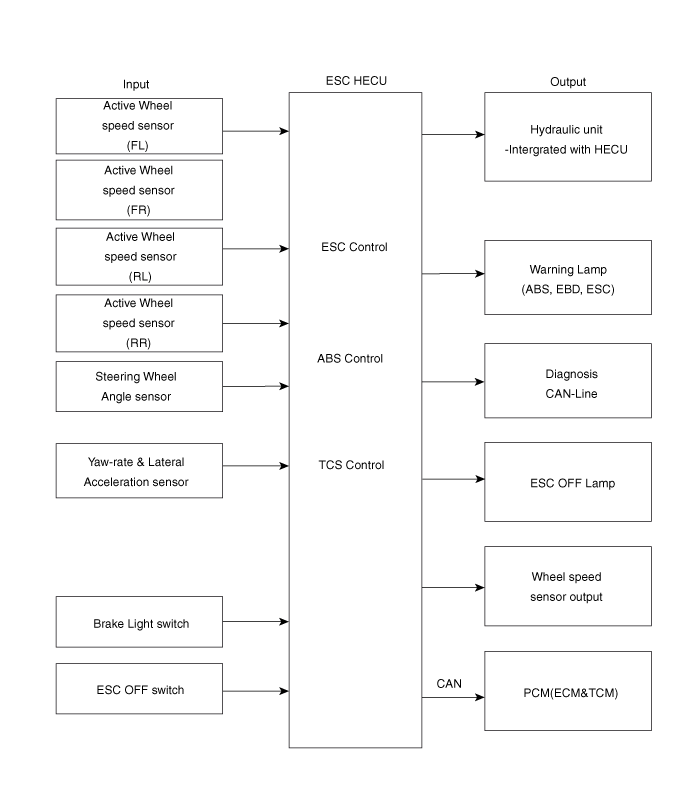 Kia Soul: Description of ESC
Kia Soul: Description of ESC
Kia Soul 2014-2019 PS Service Manual / Brake System / ESC(Electronic Stability Control) System / Description of ESC
Electronic Stability Control (ESC) recognizes critical driving conditions,
such as panic reactions in dangerous situations, and stabilizes the vehicle
by wheel-individual braking and engine control intervention with no needfor
actuating the brake or the gas pedal.
ESC adds a further function known as Active Yaw Control (AYC) to the ABS,
TCS, EBD and ESC functions. Whereas the ABS/TCS function controls wheel slip
during braking and acceleration and, thus, mainly intervenes in the longitudinal
dynamics of the vehicle, active yaw control stabilizes the vehicle about its
vertical axis.
This is achieved by wheel individual brake intervention and adaptation
of the momentary engine torque with no need for any action to be taken by the
driver.
ESC essentially consists of three assemblies : the sensors, the electronic
control unit and the actuators.
Of course, the stability control feature works under all driving and operating
conditions. Under certain driving conditions, the ABS/TCS function can be activated
simultaneously with the ESC function in response to a command by the driver.
In the event of a failure of the stability control function, the basic
safety function, ABS, is still maintained.

Description of ESC Control
ESC system includes ABS/EBD, TCS and AYC (Active yaw control) function.
ABS/EBD function : The ECU changes the active sensor signal (current shift)
coming from the four wheel sensors to the square waveform.By using the input
of above signals, the ECU calculates the vehicle speed and the acceleration
& deceleration of the four wheels.And, the ECU judges whether the ABS/EBD should
be actuated or not.
TCS function prevents the wheel slip of drive direction by adding the
brake pressure and engine torque reduction via CAN communication.TCS function
uses the wheel speed sensor signal to determine the wheel slip as far as ABS
function.
AYC function prevents unstable maneuver of the vehicle. To determine the
vehicle maneuver, AYC function uses the maneuver sensor signals(Yaw Rate Sensor,
Lateral Acceleration Sensor, Steering Wheel Angle Sensor).
If vehicle maneuver is unstable (Over Steer or Under Steer), AYC function
applies the brake pressure on certain wheel, and send engine torque reduction
signal by CAN.
After the key-on, the ECU continually diagnoses the system failure. (self-diagnosis)If
the system failure is detected, the ECU informs driver of the system failure
through the BRAKE/ABS/ESC warning lamp. (fail-safe warning)

Input and Output Diagram

 Components
Components
1. ESC Control Module (HECU)
2. Front Wheel Speed Sensor
3. Rear Wheel Speed Sensor
4. Yaw-late & Lateral G Sensor
5. Steering Wheel Angle Sensor
6. ABS Warning Lamp
...
 ESC Operation Mode
ESC Operation Mode
1.
STEP 1
The ESC analyzes the intention of the driver.
2.
STEP 2
It analyzes the movement of the ESC vehicle.
...
See also:
Control Cable Installation
When installing, set room side shift lever and T/M side lever
to "4rd" gear position.
1.
...
45,000 miles or 36 months
❑ Inspect air cleaner filter
❑ Inspect air conditioning compressor, air conditioner refrigerant and performance
(if equipped)
❑ Inspect cooling system *1
❑ Inspect dri ...
MENU : My Music Mode
In My Music mode, press the
key to set the Repeat, Random, Information, Delete, Delete All, and Delete Selection
features.
...
